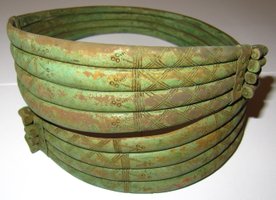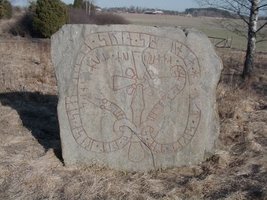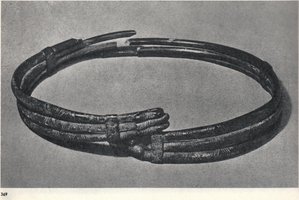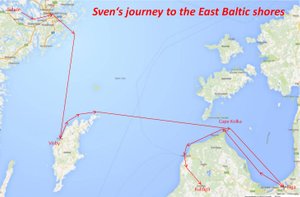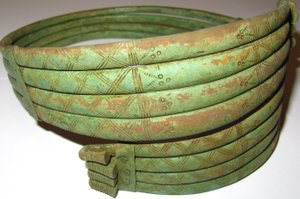Well. I could have been with these stones until after dark, but as my wife wanted to travel on.. well.. I see you again, some day, hogback stones from Gosforth. And if you happen to be there one day, do not forget that monument on the outside...
Further on with the Cumbrian hogbacktour !
In - yes, luckily again in - St. Peter's church in Heysham, there is a truly beautiful hogback stone. The guide told us, it had been studyied by Thor Ewing, a writer, in 2000. in 'Understanding the Heysham hogback' A tenth century sculpted stone monument and its context (link), Thor Ewing tells in detail what he dicovered on the both sides of this hogback stone.
Just being brought in the church as late as the 1970's accompanied with some protest here and there among the church visitors, considered as being a token of old paganism, it had been remarkably nice preserved, and a lot of detail can be seen, still. Truly worthwile a visit.
I had a small debate with the guide in the church if the - zoomorphic, in my opinion - faces on the sides were lions (or hippo's). The guide doubted if the vikings could have known about lions. Well I guess so, concerning the runes on the Ancient Greek lion statue at the Arsenal, Venice. For example. Vikings did travel south..
But when he told me he was doubting the vikings 'discovered' (as the native inhabitants were of course, in the first place) America before Columbus, I decided to rest my case..
One has to know when to start and to end a conversation ..
Just discovered the book in a bookstore written by Geoff Holder - The guide to the mysterious Lake District, I knew there had to be another hogback stone in Lowther, St. Micheal's Church. With a promising image described in the text of 'a naval and a land-based force of shield-bearing vikings above a fish and what might be a coiled sea serpent. On the reverse is a row of female figures with snakes, possibly a representation of the hideous hag Hel'. Wow. If that did not sound as a true pagan promised land ..
Not complaing too much after all we have seen, this visit was the dissapointing one of them all. But if you wife states 'I am happy to have seen them' and I am answering 'Measuring is knowing' and the even more obligate verb 'handling 'if we did not see it at all, we wouldn't have known anything at all of how they were looking' the glass was again half full, at the last day of our journey..
The hogback stone appeared to be just being tolerated within the entrance segment part of the church. As something you never use anymore but you do not throw away - entirely. That sort of feeling emerged when seeing this hogback asylum seekers.. Bed, bath and bread, ás we say in Dutch, but no luxury at all and standing on some outcuts of wood, you would balance the table with at home..
Come on, St. Micheal's Church.. care a bit more of your 'children' !
This hogback stone was moved in the church in 1907. Hogback stones layed partially buried in the churchyard before it was dug up and moved into the church.
The promising depiction of a longship - as certainly can be seen after some studying - see http://vikingminds.co.uk/pages/longship
we have missed !
The stone itself is (157 x 50 x 30 cm) and very worn.
The hogback stones in Cumbria - very diverse in quality, but everyone worth a visit ! Especially on a gloomy day in late October ...
The churches to visit - see photos of resp. St. Andrew's church in Penrith, St. Mary's church in Gosforth, St. Peter's church in Heysham and St. Micheal's church in Lowther.
Did I miss out on another one in Cumbria ? Let me know !
In a next blog I will take you to four - still remaining utterly mysterious- statues 'guarding' the graveyard of St. Andrew's church in Dacre..
For the last blog of October 9th see this link.
The artefacts....
On the subpages above, I will show a digital museum tour alongside my viking artefacts. Besides a detailled describtion, I will place them in their context of how they were used in every day viking life en add references to books where they are published in (or a similarlike example),literature, publications or studies when appropiate.
When I have questions about a type of artefact, I will mention so, and invite everyone to share his opinion.
The joy of collecting artefacts is holding an item + 1000 years old and be able to touch a mystery...
Who made it and for who ? How would the person have looked like who casted it.. ? Who buyed or received it and when ? Who whore it and what did other vikings think of the person who used the item.. where was it made/found (often not known precise). What is the meaning of some decorations on a piece ( we often do not know)..
And not the last.. what would the person to where it belonged to, would think of an middle aged man in Holland, holding it in his hands that 1000+ years later and wondering about al these mysteries... ?
<script>
(function(i,s,o,g,r,a,m){i['GoogleAnalyticsObject']=r;i[r]=i[r]||function(){
(i[r].q=i[r].q||[]).push(arguments)},i[r].l=1*new Date();a=s.createElement(o),
m=s.getElementsByTagName(o)[0];a.async=1;a.src=g;m.parentNode.insertBefore(a,m)
})(window,document,'script','//www.google-analytics.com/analytics.js','ga');
ga('create', 'UA-56164482-1', 'auto');
ga('send', 'pageview');
</script>
December 18th 2014 -
a guest blog by Daniel B.
(words and images Daniel, except from the runestone see: http://bodilzalesky.com/blog/2006/12/13/mervallastenen-mera-sten/)
A runestone and a Curonian neck torc
this is a runestone at Selaö, an island in lake Mälaren, Sweden.
siriþ· lit· resa· stan · (þin)a (· ) at· suen· sin· (b)unta· h(n)· uft· siklt· til· simkala· turu(m)·knari· um· tumisnis
The inscription means: "Sigrid erected this stone for Sven, her husband. He sailed with his valuable Knorr to Zemgale, driving past Domesnes."
So Sven sailed with his heavy tradeship to the ancient territory of the Semigallian tribe, passing Domesnes, nowadays called Cape Kolka. It is the most northern point of the ancient province of Kurland in Latvia.
Lauma, the daughter of a mighty Curonian chieftain..
What has Sven done there? I think he was trading Arabian silver, bronze cast jewellery he took up in Gotland, amber and furs. When he came back and crossed Cape Kolka again, he stopped in Kurland and met Lauma (which means forest spirit), the daughter of Ilmārs, a mighty Curonian chieftain.
Lauma was promised to a Semigallian local prince to strengthen her father's influence in the central territories and to improve the relationships between Curonians and Semigallians. But Lauma would not accept her destiny of being married to a men she didn't love...
Sven came back from his trip to Zemgale and entered the shores of Kurland, where he sailed down the Venta, and finally came to the town of Kuldīga for trading the rest of his valuable goods that he could not sale at the mouth of river Rīdzene (where Riga is situated today). When Ilmārs allowed Sven to trade his goods on the market place, Lauma met him and both fell in love the first time they saw each other.
A secret relation
As Laumas father should not know about the relationship and also Sven wanted nobody to know this, for his wife Sigrid had many contacts with other tradesman who headed into this area, the two needed to meet secretly. Since Lauma loved to play in the nearby woods when she was a child, she knew many hidden places where nobody could find them. But Ilmārs got suspicious, as he recognized that his daughter went to the market place in the afternoon nearly every day, when all trade was already done, and coming back not before the late evening.
So he sent a group of his guard to follow Lauma unremarkably. As Sven and Lauma reached their secret place and loved each other, they were trapped by Ilmārs' armed soldiers. Sven, just bearing a small knife but no other weapon, could not protect Lauma, who struggled against her father's men and lost her expensive bronze neck torc, before both were brought back to town and interrogated by Ilmārs. Although he loved his daughter, he could for political reasons not accept that she would marry another man than the prince. Therefore she was sent to the town of Ogre immediately, where the wedding ceremony was held.
Paying the price of love
Sven had to pay a penalty in the weight of 10 silver dirhams to Ilmārs and was forbidden to enter Kuldīga and trade his goods ever again. So he sailed back to his loving wife in Sweden, where he kept the secret, ashamed of his disloyality, and forgot about Lauma over the years. But he continued sailing and trading his commodities and became honorable and famous, so his wife decided that his first journey to the eastern shores should be remembered by a runestone. It was placed at the island of Selaö, nearby their home, by Sigrids brother Wieland, a passionate stone carver.
Nothing reminds of the short, unlucky love in the mild spring of the year 1028, only an amazing piece of female jewellery found in 1m depth below the ground, besides a forest road in the woods nearby the town of Kuldīga...
Words: Daniel B.
Note: I'd like to express my thanks to Daniel, who stumbled upon my website a while ago and in who I have met a kind of brother in Viking Age artefacts 'madness'.
Reading my first blog, he was inspired in writing his own phantasy story linked to an artefact he has in his collection. Although 'totally phantasy' is not the right term here as he states:
'The story of course is from my imagination, but based on the real runestone and of course the provenance of my corresponding artefact, which was found as described in the text. I decided to date the story to 1028, as the torc is dated from 9th to 12th century, and the runestone is also dated to 1000, which of course cannot be said precisely, just according to the picture style'.
Background information and reference:
A copy of the runestone of Selaö is also exhibited in Latvijas Nacionālais Vēstures muzejs in Riga, so people seem to remember Sven even there. Mervallastenen is only one of approximately 100 runestones telling us of Swedish guys travelling over the Baltic Sea eastwards, each with it's own story to inspire our fantasy of adventures in ancient times.
Book reference for my torc:
Author: Kulikauskienė R., Rimantienė R.
Title: Lietuvių liaudies menas. Papuošalai (I knyga)
Pubication: 1958 (I think in Vilnius)
Languages: Lithuanian, Russian
The picture reference is no. 369 in the book (see attached photo scan). This piece was found in Šaukotas, Central Lithuania, and has an inner diameter of 16 cm, but consists only of three single strands which are partly broken.
Daniel's description of the torc:
Curonian forged bronze neck torc riveted togther from four single strands bent backwards at the end, with punched and filed geometrical ornaments in shape of continuous and open-work lines and circles
Symbolism: Curonian expression of the mythical hill symbolising the roof of the world, and the three positions of the sun (sunrise, zenith and sunset), also found in context of other tribes (for example Latgallian)
Dated 9th-12h century, oval shape, largest inner diameter 17 cm, weight approx. 500 grams, museum quality
It was found besides a forest road in 1m depth in the woods nearby Kuldīga, Western Latvia (historical Kurland).
References: (as always, links to where the books can be ordered are attached).
Edwards, B.J.N. Vikings in North West England - The artifacts (1998);
Emery, Gordon, CURIOUS CUMBRIA, The Lake District & Beyond: A celebration of Cumbria (2023)
Ewing, T. 'Understanding the Heysham hogback' A tenth century sculpted stone monument and its context ;
Hall, R. Viking Age archaeology in Britain and Ireland (first printed 1990, reprinted with amendments in 1995);
Holder, G. The guide to the mysterious Lake District (2009)
possibly also (as there within the part of Cumbria dealing with Carlisle, the Eden Valley, Barrow-in-Furness, Whitehaven and the west coast is being dealed with)
Holder, G. Paranormal Cumbria (2010)
http://vikingminds.co.uk/pages/longship
